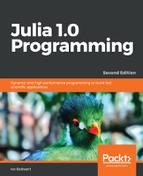Here is another type with only default constructors:
# see the code in Chapter 6inner_constructors.jl
mutable struct Person
firstname::String
lastname::String
sex::Char
age::Float64
children::Array{String, 1}
end
p1 = Person("Alan", "Bates", 'M', 45.5, ["Jeff", "Stephan"])
This example demonstrates that an object can contain collections, such as arrays or dictionaries. Custom types can also be stored in a collection, just like built-in types, for example:
people = Person[]
This returns 0-element Array{Person,1}:
push!(people, p1)
push!(people, Person("Julia", "Smith", 'F', 27, ["Viral"]))
The show(people) function now returns the following output:
Person[Person("Alan", "Bates", 'M', 45.5, ["Jeff", "Stephan"]),
Person("Julia", "Smith", 'F', 27.0, ["Viral"])]
Now we can define a function fullname on type Person. You will notice that the definition stays outside the type's code:
fullname(p::Person) = "$(p.firstname) $(p.lastname)"
Or, slightly more performant:
fullname(p::Person) = string(p.firstname, " ", p.lastname)
Now print(fullname(p1)) returns Alan Bates.
If you need to include error checking or transformations as part of the type construction process, you can use inner constructors (so-called because they are defined inside the type itself), as shown in the following example:
mutable struct Family
name::String
members::Array{String, 1}
big::Bool
Family(name::String) = new(name, String[], false)
Family(name::String, members) = new(name, members,
length(members) > 4)
end
We can make a Family object as follows:
fam = Family("Bates-Smith", ["Alan", "Julia", "Jeff", "Stephan",
"Viral"])
Then the output is as follows:
Family("Bates-Smith",String["Alan","Julia","Jeff","Stephan","Viral"],true)
The keyword new can only be used in an inner constructor to create an object of the enclosing type. The first constructor takes one argument and generates a default for the other two values. The second constructor takes two arguments and infers the value of big. Inner constructors give you more control over how the values of the type can be created. Here, they are written with the short function notation, but if they are multiline, they will use the normal function syntax.
Note that when you use inner constructors, there are no default constructors any more. Outer constructors, calling a limited set of inner constructors, are often the best practice.
